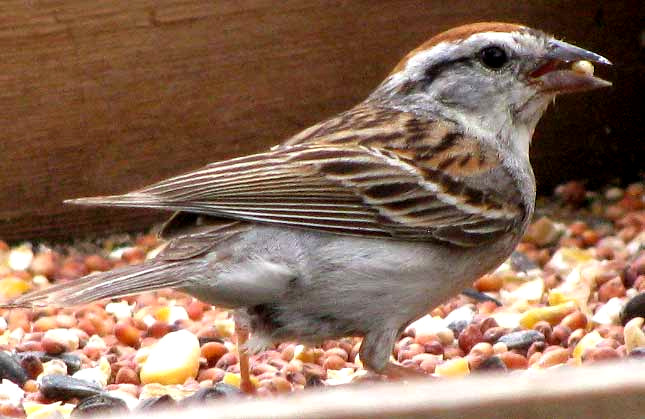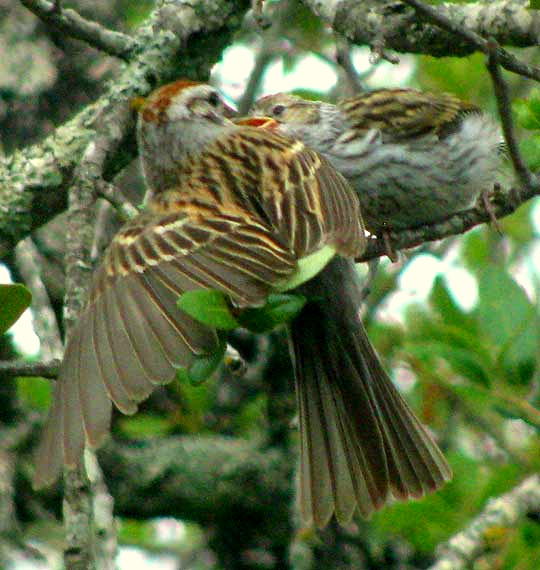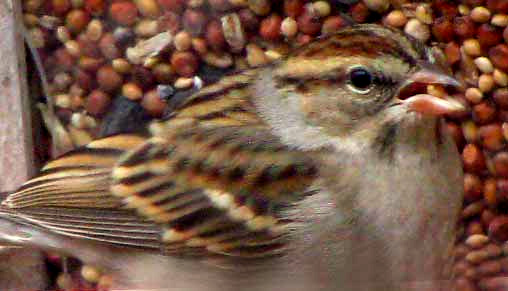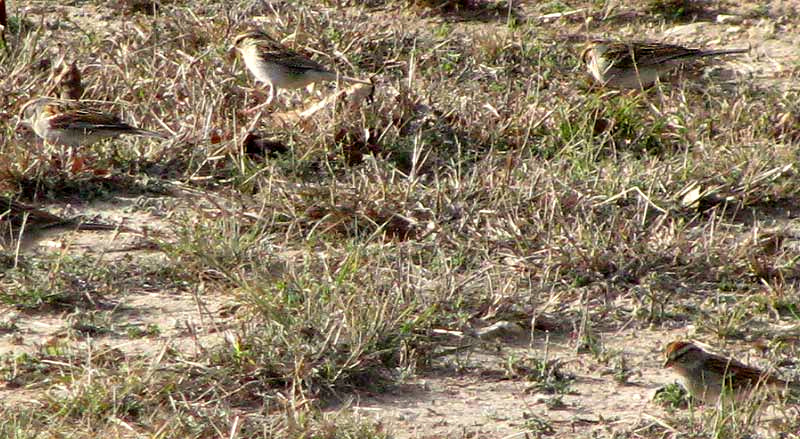Excerpts from Jim Conrad's
Naturalist Newsletter

from the June 30, 2013 Newsletter issued from the valley of the Dry Frio River in northern Uvalde County, southwestern Texas, on the southern border of the Edwards Plateau; elevation ~1750m (~5750 ft); N29.62°, W99.86°; USA
ANALYZING A SPARROW
The sparrow shown above landed in the birdfeeder of my neighbor Phred. Note that below the solid rusty crown there's an eye stripe that's neither pure white, like a Chipping Sparrow's, nor dusky, like a Rufous-crowned Sparrow, and below the eye stripe a dark line passes through the eye, which both those species display. In this part of the country the Chipping and the Rufous-crowned Sparrows are the only summer residents displaying this combination of field marks, so which is it?
Rufous-crowned Sparrows have dark "whiskers" -- dark lines slanting down from the base of their lower mandibles -- which Chipping Sparrows lack. This bird displays a hint of such whiskers. Chipping Sparrows exhibit white wing bars, but not Rufous-crowned Sparrows; our bird presents only a hint of such bars.
Apparently this is an immature bird on which the field marks aren't yet fully developed -- no pure white eye stripe or conspicuous white wing bars if it's a Chipping Sparrow, and no definite whiskers if it's a Rufous-crowned. I just couldn't decide which it was so I sent the picture to my old birding buddy Jarvis in North Carolina, who normally gets his bird IDs right. He replied:
"The very white eye stripe, the lack of a conspicuous whisker mark, and the presence of wing bars, though faint, confirm my impression that it's a Chipping Sparrow."
Well, now that he mentions it, it's true that Rufous-crowned Sparrows don't develop white wing bars even as poorly developed as the ones in the picture, and that whiskers of even immature Rufous-crowned Sparrows are more solid than the thin line on ours.
Well, there's an example of how bird IDing works, and how a genuine bird expert analyzes his birds.
from the May 25, 2014 Newsletter issued from the Frio Canyon Nature Education Center in the valley of the Dry Frio River in northern Uvalde County, southwestern Texas, on the southern border of the Edwards Plateau; elevation ~1750m (~5750 ft); N29.62°, W99.86°; USA
FLEDGLING-FEEDING TIME
Nowadays at the bird feeder new species are showing up, such as Painted Buntings, Blue Grosbeaks and White-winged Doves. Also now here and there in the liveoak branches just beyond the feeder throughout the day you see shy-acting birds perched with their heads pulled into their shoulders and occasionally quivering their wings. These are fledglings eager to encourage their parents to come plop food into their mouths. The harried parents grab seeds from the feeder, grind them a bit between their mandibles, and when particles are small enough go feed their kids. You can see a Chipping Sparrow about to deliver such a meal below:

The parents are so busy and probably so tired and with such frazzled nerves that you see them behaving more clumsily than normal, as in the picture, where the parent has landed awkwardly, tangling wing feathers with liveoak leaves.
from the December 15, 2013 Newsletter issued from the Frio Canyon Nature Education Center in the valley of the Dry Frio River in northern Uvalde County, southwestern Texas, on the southern border of the Edwards Plateau; elevation ~1750m (~5750 ft); N29.62°, W99.86°; USA
CHIPPING SPARROW'S WINTER PLUMAGE
At Juniper House we finally got a bird feeder up. I thought we'd be swamped with House Finches but so far there's only been a few Tufted Titmice of the Black-crested race, and some Chipping Sparrows. The titmice snatch a single seed from the feeder, then fly into the nearby liveoaks, wedge the seed between their feet, and pound at it with their modest little beaks. The sparrows are nearly as fidgety, except for one bird, who comes all through each day, often sitting like an old hen in the tray, looking around and leisurely picking a seed here and there. Below, you can see this bird working on a seed:

As you can see by comparing this picture with that of our June bird above, this bird's winter plumage is different from its summer one.
Even in the summer sometimes it can be hard to distinguish our several sparrow species, nearly all of which display brown-streaked backs, with the rest of the bird mostly expressing variations on the brown and gray theme. Winter plumages often are more subdued. The Chipping Sparrows' reddish cap grows brown and curdles into irregular stripes as the white eye stripe and face darken. In this plumage, in the field, they're hard to tell from several other species.
In fact, even with our picture, I didn't feel perfectly confident about declaring this a Chipping Sparrow until I ran the picture past my old birding buddy Jarvis in North Carolina. He pointed out the dark line through the eye, an important field mark for Chipping Sparrows. Rufous-crowned Sparrows also have that, but they also display a white streak at the base of their bills, the "malar streaks," and Jarvis points out that our bird doesn't have that. Jarvis also wrote, "One might also consider a Clay-colored Sparrow but a Clay-colored has a pale lore and this bird has a dark lore. Also, the border of the face mask does not look dark enough." The lore is an area between a bird's eye and the base of its top mandible.

from the February 10, 2013 Newsletter issued from the valley of the Dry Frio River in northern Uvalde County, southwestern Texas, on the southern border of the Edwards Plateau; elevation ~1750m (~5750 ft); N29.62°, W99.86°; USA
WANDERING FLOCKS OF CHIPPING SPARROWS
About a month ago nearly every day along the little gravel road leading to the cabin I'd be walking or biking along and sparrows, which would remain undetectable in the short grass until they flew up, would flutter into the air, fly a short distance back into the grass or into nearby bushes or trees. They'd fly up only one or two at a time, so it'd take awhile to realize that I was stirring up a sizable flock. I'd try to see them nearby in the grass before they flew up so I could photograph them but they were so well camouflaged that they remained invisible to me until they flew up. Day after day this happened. Sometimes the flock would number at least 50, so here we're talking about a significant rising from the grass that almost seemed magical, birds being spontaneously generated from the Earth, the bird-essence of grass gushing onto the surrounding landscape.
Gradually the little flock must have grown accustomed to me, for as days passed I could approach closer and closer before they began flying up. Also, sometimes it seemed to me that maybe they were fascinated by my daily passage, because they always gathered in grass along the road when they could have easily moved into adjacent wide fields where acres of similar short grass awaited them with no disturbances at all.
So, this week they let me approach near enough for a picture, and I like the picture because it shows exactly how they are as they forage. Typically when I see them it's well into the day when the sun is bright, even glaring, the wind is getting stiff and there's a rugged, hard-bitten, southwestern-Texas-edge-of-desert feeling in the air. The birds all face into the wind, working into it, fastidiously pecking at this or that grass seed. You can see four of the diligent foragers facing a hard south wind blowing up the canyon at the top of this page.
They're Chipping Sparrows, easily recognizable with their rusty crowns and white eye stripes underlined with black lines running through their eyes. Back in Mississippi one of the best signs of spring is when the Chipping Sparrows' dry, monotonal trills come wafting through the Loblolly Pines on sunny afternoons. However, probably it's too early for them to be trilling there now, nor are they making a peep here. In Mississippi I've not seen such large flocks of them as here. Later in spring their flocks will break up, pairs will form, and males will establish and defend territories of about an acre (0.4ha).
But, now in early February, all that activity belongs to another world for these hard-working, facing-into-the-wind little winter birds who seem receptive to the bother I cause them each day along the gravel road.
Here on the southern boundary of the Edwards Plateau we seem to be on the exact boundary between where Chipping Sparrows are present only during the winter, and where they occur year round.
from the February 2, 2009 Newsletter, issued from the forest near Natchez, Mississippi; elevation ~400ft (120m), ~N31.47°, ~W91.29°:
CHIPPING SPARROWS IN NONBREEDING PLUMAGE

When Karen cleans her birdcages she tosses what's on the cage floors to a certain spot in her yard. Many seeds are in the mess, so wild birds come to forage there. That's what the above Cardinal was doing when I photographed him, and that what the Chipping Sparrows, SPIZELLA PASSERINA, are doing in the picture above.
Chipping Sparrows occur here year round, though not necessarily the same individuals. The species is migratory, breeding in most of Canada and the US, except for parts of the US Deep South, and wintering from the southern US south through Mexico to Nicaragua.
Breeding adults are recognized by their bright, rusty- red or rufous crowns, white eyebrow, and black eye stripe. These features are much less sharply defined in the nonbreeding birds in the picture. The crown of the bird on the left even has a gray stripe down its middle, which is absent in breeding adults.
From past experience I know it won't be long until the Chipping Sparrow's dry, monotonal trill comes wafting through the Loblolly Pines on sunny afternoons. I don't hear them yet, but I'm waiting for it hard.